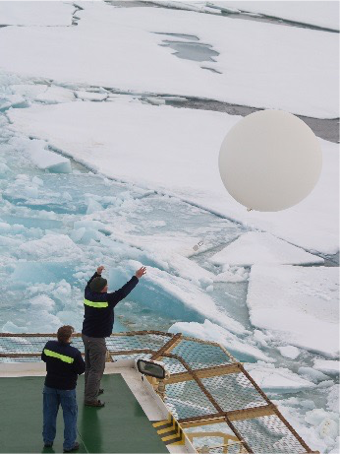Michael Tjernström
Radiosoundings were launched every six hours (00, 06, 12 & 18UTC), and additionally before each helicopter flight (if not at one of the normal times), using Vaisala RS92 sondes. Balloons were launched from the helipad of the icebreaker Oden, about 13 m above sea level. The sonde measures pressure, temperature and relative humidity as the balloon roses through the air, at about 4-6 ms⁻¹. From temperature and pressure, altitude is calculated using the hydrostatic relationship. Winds are measured by tracking the sonde using GPS.
Download data
Visit web site
Citation
Michael Tjernström (2018) Radiosoundings from the high-Arctic ASCOS expedition 2008. Dataset version 1. Bolin Centre Database. https://doi.org/10.17043/oden-ascos-2008-radiosoundings-1
References
Tjernström, M. et al. 2014. The Arctic Summer Cloud Ocean Study (ASCOS): overview and experimental design. Atmospheric Chemistry and Physics, 14, 2823–2869. https://doi.org/10.5194/acp-14-2823-2014
Data description
The zip-file contains one matlab file with a selfexplaing struct of all the sounding data interpolated to a common height grid (with an equal or higher resolution than the original data), 145 (one for each sounding) ASCII files with columns of:
1: Height (m)
2: Pressure (hPa)
3: Time from launch (sec)
4: Sondes longitude (deg)
5: Sondes latitude (deg)
6: Temperature (degC)
7: Potential temp. (degC)
8: Equivalent pot. temp. (degC)
9: Relative humidity wrt water (%)
10: Relative humidity wrt ice (%)
11: Specific humdity (g/kg)
12: Dew point (degC)
13: Wind speed (m/s)
14: Wind direction (deg)
15: West-East wind speed component (m/s)
16: South-North wind speed component (m/s)
The zip-file also contains plots of a selection of variables for each sounding.
The soundings are QC:ed; the bulk of the data rests on the so called "research mode" sounding simulation based on the raw data saved during the expedition. This has been manually checked and compared to the operational sounding that came from the expedition. In cases when they disagree, more weight has been put on the research mode simulation. In cases where the research mode simulation lacks data but the original does not, the latter has been filled in.
The resulting merged soundings was also checked for physical consistency and when data was
judged bad it was replaced by NaN.
Checks have been performed comparing the lowest levels to the Oden weather station and to
the metalley mast. The lowest portion was also compared to the tethered soundings. Some
systematic discrepancies remain but are all with the excpected accuracy of the instruments.
Comments
Radiosoundings were launched every six hours (00, 06, 12 & 18UTC) and additionally before each helicopter flight (if not at one of the normal times), using Vaisala RS92 sondes. Balloons were launched from the helipad of Oden about 13 m above sea level, while the Vaisala DigiCORA receiving station was located on the port side of the 7th deck.
Soundings measure pressure, temperature and relative humidity as the balloon roses through the air, at about 4-6 ms-1. From temperature and pressure, altitude is calculated using the hydrostatic relationship. Winds are measured by tracking the sonde using GPS. The data has been through several QC procedures and raw sounding data has been reprocessed using the available surface observation operating in so-called “research mode”; bad or dubious values are replaced by NaN.
For a few soundings the RS92 sensor package was complemented either by radioactivity or ozone sensors.
Original address: http://www.ascos.se/index.php?q=node/232
Files:
OdenSoundings.zip (25.17 MB)
